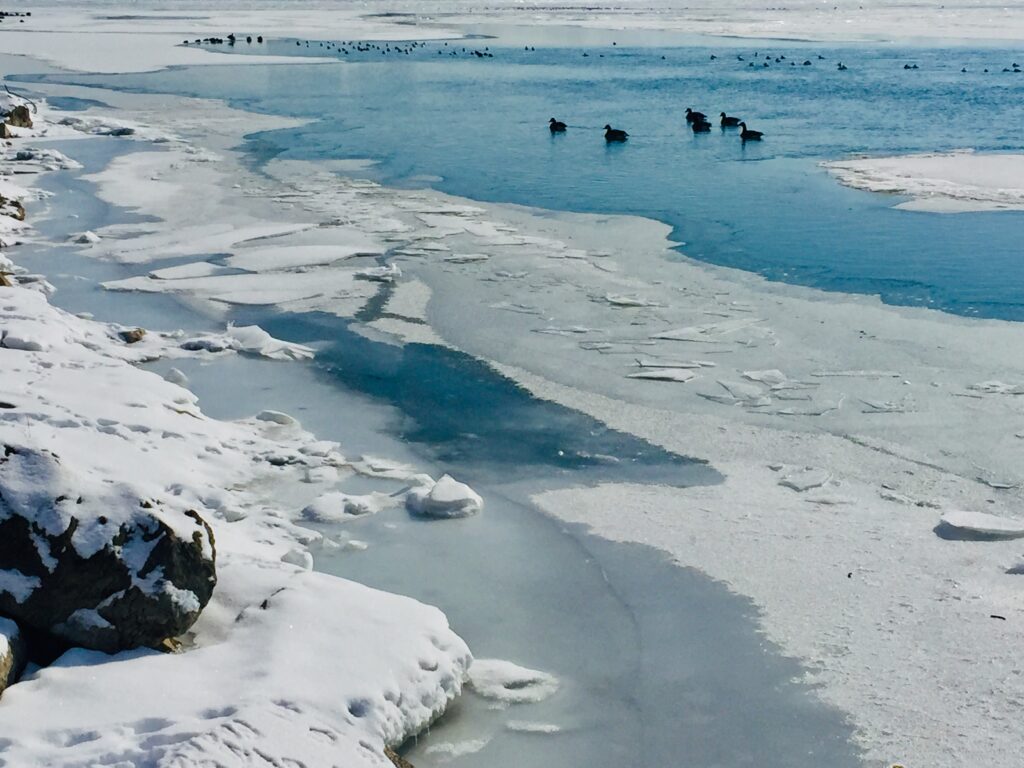A few weeks ago, we stood at the edge of Belle Isle, where the Detroit River meets Lake St. Clair, watching the first sheets of ice rumbling into the shoreline like a slow moving freight train. This would normally have occurred a month earlier. Climate change has made ice watch part of the weather report. In fact, this week, the Weather Channel announced by headline: “Great Lakes Ice Cover Made a Roaring Comeback in a Frigid February, especially on Lake Erie.” We’re told that Lake Erie is 81 percent frozen, while on average, about 25 percent of the overall Great Lakes surface is covered.
Weather has become a spectator sport, and one of the more quirky advisories is how the ice is forming on the lakes. That makes sense if you fish on ice, or race on ice, or skate and play hockey (as they are now in Marquette, Michigan, where an unusually glassy sheet of ice coverages the Lake Superior near the shore, offering excellent conditions for skating). However, there is serious concern behind the headlines: climate change. The reduction in ice time on the lakes over the past decades has caused climatologists to worry about the loss of the world’s largest body of fresh water through evaporation. The story made the Washington Post, which noted that Great Lakes ice coverage hit an all-time low in January.
For many of us, watching the ice form is an aesthetic pastime. It’s about as exciting as watching paint dry, in a sense. You make your way to the shore and watch as the ice sheets pile up further and further from the shore and the gaps between ice sheets become diminishing ponds where ducks can still paddle. Watching ice form takes time and attention. It gets cold standing out there. You go away and come back a few days later to monitor how much more ice has formed — and speculate whether it will freeze over this year.
From an aesthetic perspective, this is the time to watch the emergence of “blue ice,” as visualized in a series of photographs published in the Detroit Free Press recently of the waters off Northern Michigan. For most of us, it’s a more subtle, aesthetic pursuit. The Bearskin blog, written by the McCloughan family which owns the Bearskin Lodge on Bearskin Lake, captures the art of watching ice form in a November, 2008 blog post in which they wrote about a final canoeing expedition where they noticed “the shorelines of the lakes were ringed with borders of brittle, chunky ice.” A month earlier the blog wrote about waiting for snowflakes. It’s what you do at a lake during the winter. “Whatever happens, it’s a very quiet time here at Bearskin right now, so keeping an eye on the changing ice qualifies as our current form of daily entertainment.”
Naturalists know what to look for in ice formations; something that those of us passersby stumble on. For example, what about those “ice bubbles?” According to the Schlitz Audubon Nature Center in Wisconsin, ice bubbles are “grayish spherical shapes that can get quite large, or can be so small they look like a thin, hazy layer spread like little points throughout the frozen water. You will also see crystalline shapes made of fallen leaves, twigs, and other items, which freeze underneath the surface. Look for rings, too. Sometimes rings surround a branch rising from the surface of the frozen water. You can also find them by the shore, where water froze by the edge of the land.” If you’re interested in the science behind this phenomenon, check out the nature center’s website: https://www.schlitzaudubon.org/2018/12/24/the-art-and-science-of-ice-formations/.
And if you’re really interested in the science of ice formation and have a taste for philosophical inquiry, blogger Samantha Cole writes about ice being created in a science experiment with dry ice: “…we see in detail how ice crystals form, springing into geometric feather-like shapes. It looks like a tiny icy forest, or a bed of blue ferns. Watch it enough times and it starts to get soothing in a deep, subliminal way. Watch it too many times and you’ll start to wonder what the point of anything is. We’re all just built to form and grow and create something new before dissolving back into the puddles we came from, and I swear to god I’m not even high right now.”
Yes, for some, like Cole, watching ice form can be a “religious experience… A rare view of the impossibly intricate, alien-like structures that a warm human touch would instantly demolish. So fragile. Life. Love. Hurt. Pain. Geometry. Creation. Destruction. Ice.”
As Freud might have said, sometimes, ice is simply ice, necessary to preserve our world’s largest supply of fresh water, and worth watching as it takes shape.
Blog written by Dennis Archambault
Photo of the waters off Belle Isle
